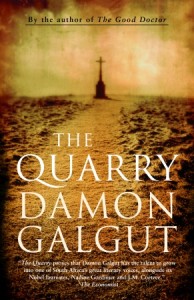 ASIDE: I know I’m skipping #63 – I read Chester Brown’s Paying For It a couple of weeks ago but feel that it is a book best discussed in person. Also, I’m waiting for my RRHB to finish it too so we can discuss it before I actually pull all of my thoughts together. So, The Quarry. Of course, I always finish really big books really late at night. Even though I’m this-close to sleep, I always need to start another book. Generally, I pick something short. Damon Galgut’s The Quarry fit the bill — the entire book clocks in at 202 pages. Perfect for those moments in between epic reading undertakings.
ASIDE: I know I’m skipping #63 – I read Chester Brown’s Paying For It a couple of weeks ago but feel that it is a book best discussed in person. Also, I’m waiting for my RRHB to finish it too so we can discuss it before I actually pull all of my thoughts together. So, The Quarry. Of course, I always finish really big books really late at night. Even though I’m this-close to sleep, I always need to start another book. Generally, I pick something short. Damon Galgut’s The Quarry fit the bill — the entire book clocks in at 202 pages. Perfect for those moments in between epic reading undertakings.
But to dismiss Galgut’s work as simple or frothy just because of its size would be a mistake. He’s not an easy writer. He’s a succinct, sharp, unpunctuated writer, but that doesn’t necessarily mean the book doesn’t carry weight. Like I’ve mentioned in other reviews of his work, Galgut reminds me of Coetzee. They similar sparse prose and they use violence as a backdrop to open a much larger, richer conversation about the state of society.
As the novel opens, the main character who is never directly named (with the exception of the name he takes later on, which is not his own) hides from oncoming traffic in the vast outer territories of South Africa. And by “traffic,” I mean one car. When the next car rumbles to a stop, he’s forced out of hiding in a way, and offered a ride by a minister going far north to a small church to work. They share awkward conversation and drink the communal wine. And then, the man kills the minister. It’s quick, frighteningly violent, and utterly unnecessary — but it’s the crime that sets off the major action in the book (and I’m not spoiling it by writing it here, either, as it’s on the dust jacket).
The “minister” picks up a semi-vagrant named Valentine on the edge of town. He helps direct him to the church where “the man” takes up the pulpit, convincingly. He speaks of hell and brimstone. The church going population increases. And then, when one petty crime leads to a case of serious mistaken identity, the true issues in the novel evolve. Race, class, and a moment of such bad luck that it hardly seems probable, ensure that there’s nothing but a tragic end to the tale. Galgut has a talent for writing scenes of such aching sadness — there are moments from his short story collection In a Strange Room that still make my heart pause, and this novel is no exception. To me, this is writing at its immeasurable best, but I am not sure everyone would agree with me. I am fond of short sentences with little punctuation — quite possibly because I am unable of crafting them myself. Yet, with such sparse prose it’s hard sometimes to figure out which “he” Galgut refers too and I kept having to reread parts of the book just to make sure I had the right man (Valentine, the “minister” and/or the policeman directly involved with both men). And sometimes, the cat and mouse nature of the plot wore a little thin, but I didn’t care — like McCarthy’s writing, I think I stick around for the violence, for the deprivation of humanity, for the utter terror contained within the literary pages.
Regardless, I kept trying to put the baby down for a nap sooner than I perhaps should have, and subsequently having to go back in to actually put him down for said nap, simply because I wanted to finish this novel. I’m glad he (the RRBB) took a nice long nap this afternoon that allowed me to not only finish my book but also go for a swim. Ah, the decadence.
Things I didn’t know: This must be an older novel republished in Canada — only because when I was looking for the NY Times review I found this instead: it’s a review of a film from 1998 based on the book. Who knew? And I can’t remember when my copy arrived but I’m still counting this as “off the shelves” (as well as Around the World in 52 Countries [but I’m so behind in updating either challenge page…]).